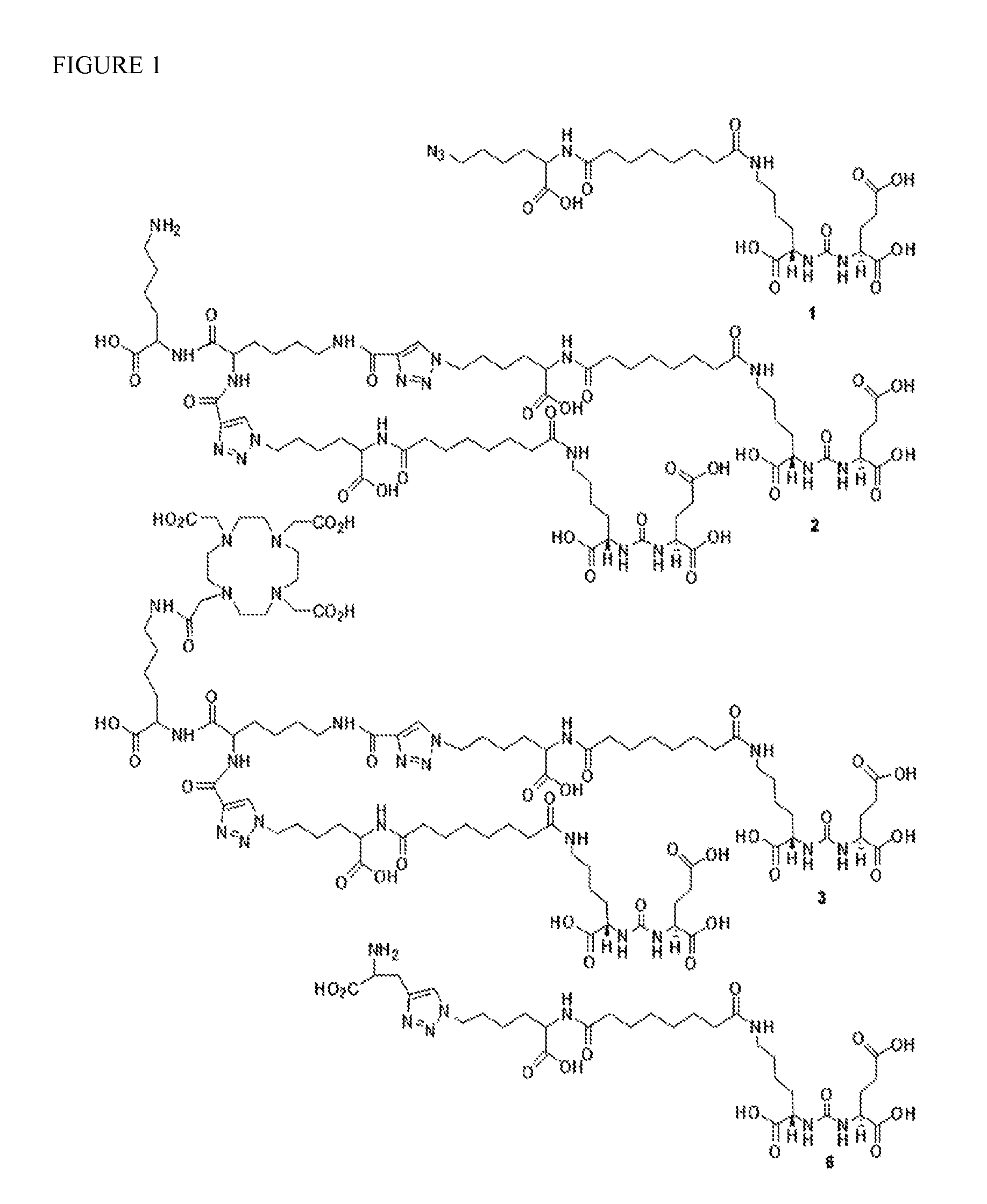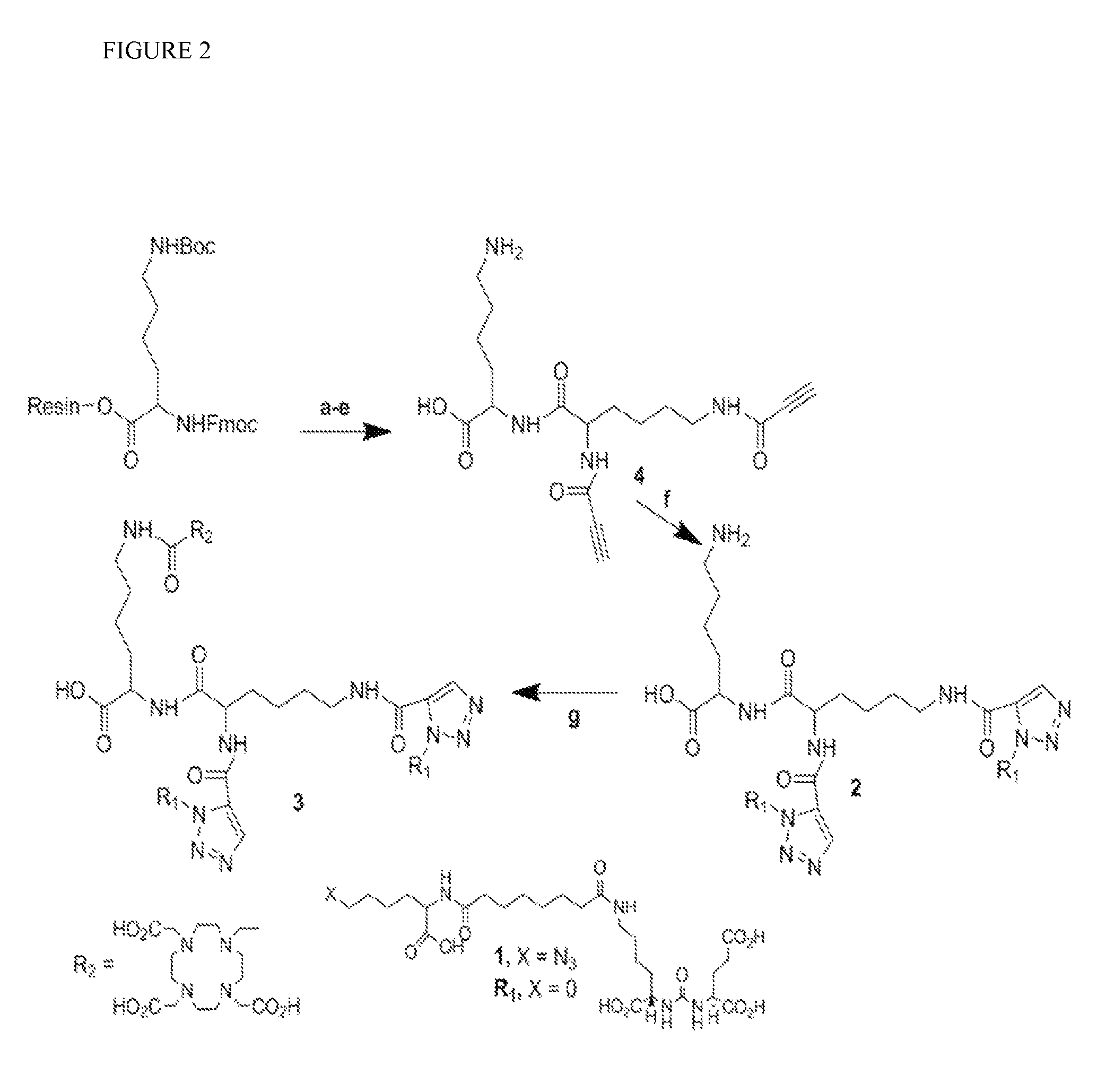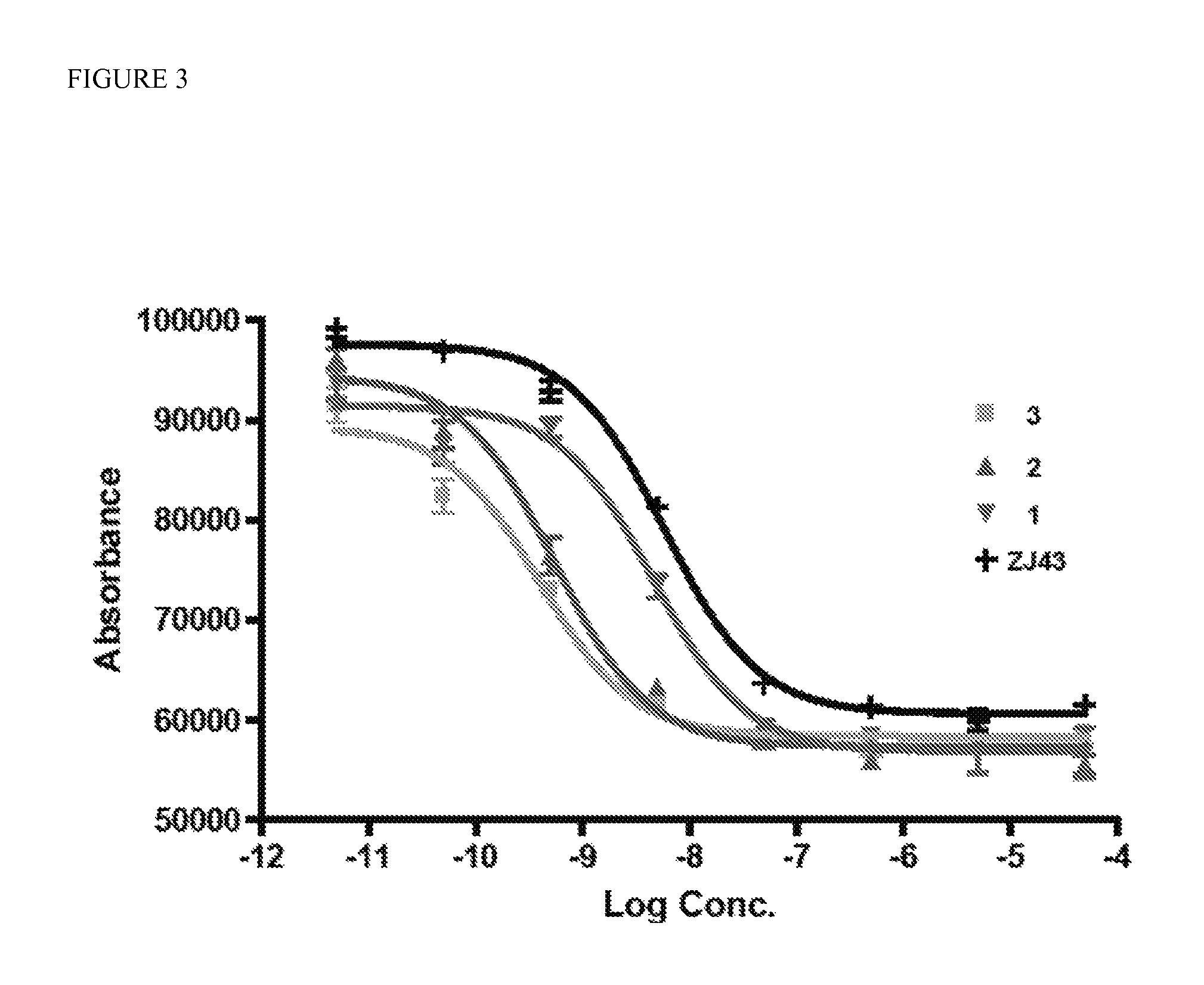Homomultivalent and heteromultivalent inhibitors of prostate specific membrane antigen (PSMA) and uses thereof
a prostate specific membrane antigen and homomultivalent technology, applied in the direction of peptides, drug compositions, peptides, etc., can solve the problems of complex chemistry used to produce them, and the image of multivalent psma-binding agents has not yet been shown, so as to improve the affinity and pharmacokinetic properties of a urea class, the effect of high avidity and affinity
- Summary
- Abstract
- Description
- Claims
- Application Information
AI Technical Summary
Benefits of technology
Problems solved by technology
Method used
Image
Examples
example 1
[0101](3S,7S)-26-Azido-5,13,20-trioxo-4,6,12,21-tetraazahexacosane-1,3,7,22-tetracarboxylic acid, compound 1. This compound was prepared following our previous report (J. Nucl. Med., (SNM Annual Meeting Abstract). 2011; 52 (Supplement 1): 293). Briefly, commercially available Boc-Lys(Azide)-OH was treated with a solution of TFA / CH2Cl2 (1:1) at ambient temperature for 4 h to remove the Boc group. After solvent removal, the crude product, H-Lys(azide)-OH, was directly used for the next step. To a solution of H-Lys(azide)-OH (50 mg, 0.29 mmol in 500 μL DMSO) was added NHS-ester of Lys-Glu urea (24 mg, 0.43 mmol in 500 μL DMSO) and DIEA (100 μL) and left at ambient temperature for 4 h. Solvent was evaporated to dryness and the residue was dissolved in water and purified by HPLC (Method 1). Retention time (Rt): 17.1 min. 1H NMR (δ, ppm, DMSO): 8.06 (m, 2H), 7.74 (m, 2H), 6.34-6.29 (m, 2H), 4.16-4.03 (m, 3H), 3.00 (m, 2H), 2.33-1.27 (m, 28H). ESI-MS m / Z: 630 [M+H]+.
example 2
6-amino-2-(2,6-dipropiolamidohexanamido)hexanoic acid, compound 4
[0102]Compound 4 was synthesized using standard Fmoc mediated solid phase peptide synthesis. Formation and masking of free amines was assessed using the Kaiser test. Washing the resin with 3 mL DMF three times, 1 minute each, before and after each step was performed until liberation of the final product from the resin. All steps were performed at ambient temperature unless otherwise mentioned. After being swollen by 3 mL DMF, Fmoc-Lys-(Boc)-Wang resin (500 mg, 0.18 mM) was deprotected by settling with 3 mL 20% piperidine in DMF×2, 5 min each time, before coupling with Fmoc-Lys-(Fmoc)-OH (318 mg, 0.54 mM) preactivated with DIEA (124 μL, 0.72 mM) and PyBOP (280 mg, 0.54 mM in 3 mL DMF). The last coupling was performed twice, 30 minutes in duration each time. The Fmoc groups were removed using 3 mL 20% piperidine in DMF×2, 5 min each time. Coupling with propiolic acid (75 mg, 1.08 mM) was achieved using a solution of EEDQ...
example 3
(7S)-26-(4-((1-((5-amino-1-carboxypenty 1)amino)-1-oxo-6-(1-((7S)-1,3,7,22-tetracarboxy-5,13,20-trioxo-4,6,12,21-tetraazahexacosan-26-yl) 1H-1,2,3-triazole-4-carboxamido)hexan-2-yl)carbamoyl)-1H-1,2,3-triazol-5-yl)-5,13,20-trioxo-4,6,12,21-tetraazahexacosane-1,3,7,22-tetracarboxylic acid, PSMA-targeted homobivalent compound 2
[0103]Compound 1 (49 mg, 76.7 μM) and 4 (0.5 eq, 14.5 mg, 38.3 μM) were dissolved in 1 mL H2O / t-BuOH (1 / 1). To that solution, sodium ascorbate (6 mg, 30 μM) and Cu(OAc)2 (3 mg, 15 μM) were added consecutively, the mixture was purged with N2 gas and stirred at ambient temperature overnight. Compound 2 was purified using C18 SepPak® Vac 2 g column through which the product was successfully eluted using 70 / 30 water / acetonitrile (0.1% TFA). Compound 2 was further purified by HPLC (Method 1). Rt: 13.9 min. ESI-MS m / Z: 1638 [M+H]+.
PUM
| Property | Measurement | Unit |
|---|---|---|
| diameter | aaaaa | aaaaa |
| pH | aaaaa | aaaaa |
| aperture size | aaaaa | aaaaa |
Abstract
Description
Claims
Application Information
 Login to View More
Login to View More - R&D
- Intellectual Property
- Life Sciences
- Materials
- Tech Scout
- Unparalleled Data Quality
- Higher Quality Content
- 60% Fewer Hallucinations
Browse by: Latest US Patents, China's latest patents, Technical Efficacy Thesaurus, Application Domain, Technology Topic, Popular Technical Reports.
© 2025 PatSnap. All rights reserved.Legal|Privacy policy|Modern Slavery Act Transparency Statement|Sitemap|About US| Contact US: help@patsnap.com



